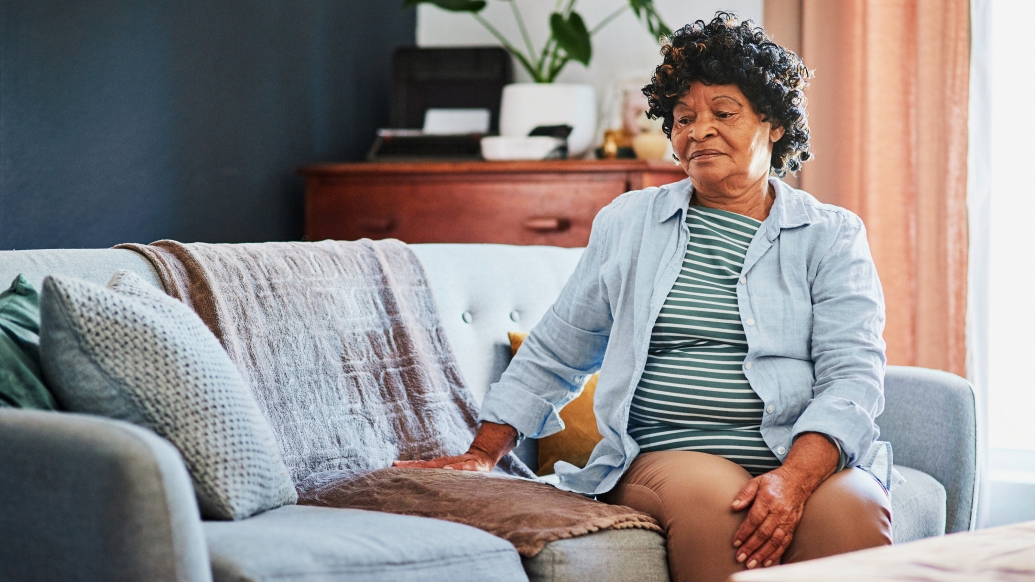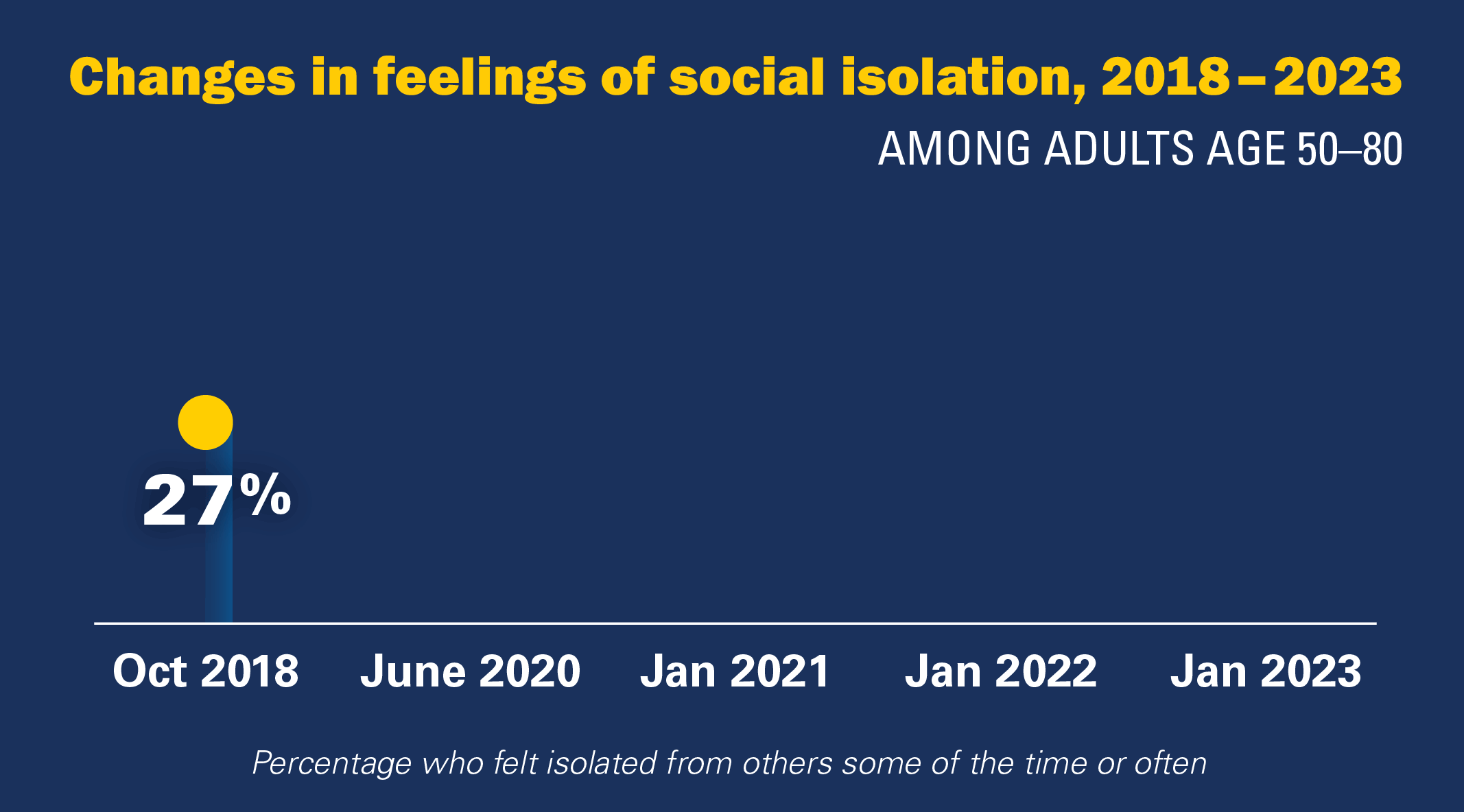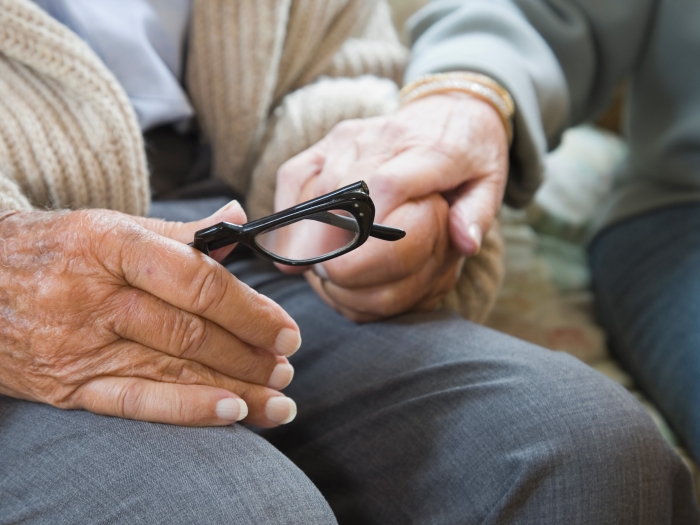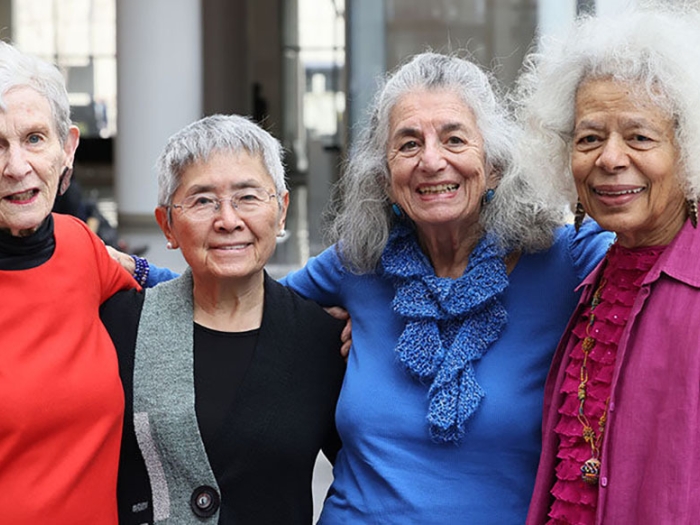Three years into pandemic, social isolation has declined, but remains higher in those with mental or physical health challenges, disabilities
10:18 AM
Author |

After three years of pandemic living, loneliness, isolation and lack of social contact have finally started to decline among older adults, a poll shows.
But one in three people between the ages of 50 and 80 still say they sometimes or often experienced these feelings, or sometimes go a week or longer without social contact with someone from outside their home. That’s down from about half of older adults in June 2020.
The percentages who currently feel lonely, isolated or lacking contact were much higher among older adults who say their physical or mental health is fair or poor, as well as those with a health problem or disability that limits their daily activities, and those who are not working or unemployed.
SEE ALSO: Loneliness Doubled for Older Adults in First Months of COVID-19 (michiganmedicine.org)
Around half or more of the older adults in each of these groups currently experience these feelings. That’s a rate about twice as high as their peers who are in better health or don’t have a disability or activity-limiting health issue.
The new findings from the University of Michigan National Poll on Healthy Aging, gathered in late January, add to previous data from polls taken in 2018 and during all three pandemic years using the same questions.
That allows the poll team to see that for older adults overall, these measures are nearly back to pre-pandemic levels, which were already high. The poll is based at the U-M Institute for Healthcare Policy and Innovation and supported by AARP and Michigan Medicine, the University of Michigan’s academic medical center.
“Three years into the COVID-19 pandemic, we see reason for hope, but also a real cause for concern,” said Preeti Malani, M.D., the poll’s senior advisor and former director, and a U-M Medical School infectious disease professor who is also trained in geriatrics. “If anything, the pandemic has shown us just how important social interaction is for overall mental and physical health, and how much more attention we need to pay to this from a clinical, policy and personal perspective.”

Emily Smith, IHPI
“Loneliness and isolation were too high before the pandemic, and it will take a concerted effort to bring these rates down further,” said poll director Jeffrey Kullgren, M.D., M.P.H., M.S., an associate professor of internal medicine at Michigan Medicine and physician and researcher at the VA Ann Arbor Healthcare System.
SEE ALSO: Risk of PTSD, anxiety, loneliness after COVID-19 hospitalization (michiganmedicine.org)
“While we must always balance risk of infection with risk of isolation in older adults, we now know that a combination of vaccination, medication, testing, ventilation and masking can protect even the most vulnerable and allow them to engage socially,” he adds.
If anything, the pandemic has shown us just how important social interaction is for overall mental and physical health, and how much more attention we need to pay to this."
-Preeti Malani, M.D.
The poll team notes that chronic loneliness has been shown by researchers to be associated with adverse impacts on mental, cognitive and physical health, general well-being, and even longevity.
More about the findings:
- Thirty-seven percent of older adults say they felt a lack of companionship in the past year, compared with 41% in June 2020 and 34% in 2018.
- Thirty-four percent of older adults reported feeling isolated from others, down from 56% in June 2020 but still higher than the 27% who said the same in 2018.
- Thirty-three percent of older adults say they infrequently (once a week or less) have social contact with family they don’t live with, or friends or neighbors, down from 46% in 2020 but higher than the 28% seen in 2018.
- In general, rates of all three measures plateaued in 2021 and 2022, down from June 2020 highs, before dropping in the January 2023 poll.
- Mental health: Rates of feeling a lack of companionship were more than twice as high among those who say their mental health is fair or poor (73%) than among those who report better mental health (excellent, very good or good). Similarly, 77% of those in the fair/poor mental health group reported feeling isolated compared with 29% in the better mental health group, and 56% of those in the fair/poor mental health group reported infrequent social contact compared with 30% in the better mental health group.
- Physical health: The differences were less stark but still large among those who reported fair or poor physical health compared with those in better physical health. Lack of companionship was experienced by 55% of the fair/poor group and 33% of the better group, isolation was experienced by 55% vs. 29% and lack of social contact was experienced by 56% vs. 29%.
- Disability or health condition: 51% of those who have a disability or health condition that they say limits their activity also say they experience a lack of companionship, compared with 30% of those without such conditions. The percentages were similar for feelings of isolation.
- Living alone: 47% of those who live alone report a lack of companionship, compared with 33% of those who live with others. There was a smaller but still measurable difference between the two groups in feelings of isolation.
Despite the modest improvement these results show, social isolation and loneliness are still an urgent concern for older adults,” notes Claire Casey, president of AARP Foundation. “Research shows that social isolation affects health and well-being, and can lead to unemployment. Greater economic security for older adults demands that we address loneliness.”
For more from AARP Foundation on social isolation, visit connect2affect.org.
The poll report is based on findings from a nationally representative survey conducted by NORC at the University of Chicago for IHPI and administered online and via phone in January 2023 among 2,563 adults aged 50 to 80. The sample was subsequently weighted to reflect the United States population. For the previous polls, a different sample of older adults was asked these questions about loneliness, isolation, and social contact, but all samples were weighted to reflect the population of U.S. adults aged 50 to 80.
Read past National Poll on Healthy Aging reports and about the poll methodology.
Data from the 2018 and 2020 polls that included questions about loneliness and isolation are available for free download and use.
Citation: National Poll on Healthy Aging: Trends in Loneliness Among Older Adults from 2018-2023. National Poll on Healthy Aging: Trends in Loneliness Among Older Adults from 2018-2023

Explore a variety of healthcare news & stories by visiting the Health Lab home page for more articles.

Department of Communication at Michigan Medicine
Want top health & research news weekly? Sign up for Health Lab’s newsletters today!





